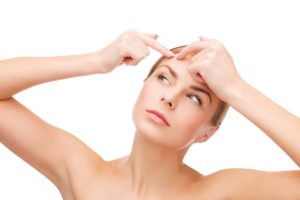
Acne can sometimes feel like a curse. Whether you’re a teenager struggling with it for the first time or an adult who can’t figure out why it won’t just go away after all these years, acne can feel like a painful burden the whole world can see. The skin disease can also have far reaching consequences, affecting self-esteem, attitudes, social interactions, academic performance and yes, even you job and salary.
But what causes these painful and unsightly pimples you’re struggling with and what can you do to combat them once they’ve started to appear?
What Exactly is Acne
Acne is a persistent inflammatory skin condition many of us have struggled with at one time or another. In fact, at least 85% of us will encounter acne between the ages of 12 and 24. It occurs when hair follicles, also known as pilosebaceous glands, on your face and body become clogged with oils and dead skin cells and results in:
- Pimples and papules
- Zits and pustules
- Whiteheads (open comedones)
- Blackheads (closed comedones)
- Cysts and nodules
While acne is commonly considered a problem for teenagers, there is no age limit to the condition and severe acne can lead to permanent scarring and emotional distress.
Common Causes of Acne
The simple truth is, there is no one factor that leads to an acne outbreak and the reason your skin is inflamed and painful differs from your friends. If you find yourself constantly battling your acne though, there are a few common culprits.
- Overproduction of Oil Glands – Acne lesions form when hair follicles are clogged with oil. Your hair follicles are connected to oil glands known as sebaceous glands, and this is why you are most likely to experience acne across your face, chest, shoulders, and upper back. Your body has more sebaceous oil glands in these areas than anywhere else.
- Dead Skin Cells – If your hair follicles are becoming clogged with oil, chances are they are also struggling with dead skin cells. Dead skin cells can block glands and trap oil beneath the surface which allows bacteria to grow forming a microcomedone, or an early acne bump, invisible to the naked eye but forming beneath the surface of your skin.
- Bacteria – How persistent your acne is and how much damage it causes may depend on the strain of bacteria that grows in the gland. P. acnes is the bacteria most commonly associated with acne lesions. This is why different antibiotics may not have the desired effect on your acne right away.
- Inflammation – The reason why your acne might be red and sore is inflammation, or the immune response acne stimulates in your body. Some people find their acne inflammation worsens with additional pressure. Once an area has become inflamed, things such as wearing a helmet or holding a cell phone to your face for extended periods of time can increase the inflammation and make acne worse.
- Hormones – Androgens are a type of hormone which includes testosterone and androstenedione. Production of these hormones increases when you enter puberty in both men and women and causes the sebaceous glands to enlarge and increase the production of oil. This is why so many of us have our first encounters with acne during our teenage years.
- Genetics – Not everything is your parent’s fault but if you suffer from severe acne, there’s a decent change one of your parents did as well.
What to Do?
For many of us, acne is a fact of life we will have to struggle with at one point or another. While some may be able to treat it with over the counter medication, for many, the formation of acne sores requires a trip to the dermatologist.
Whether you’re starting to see the early signs of your first pimples or you’ve been struggling for years with the condition, there’s no time like the present to reach out for help. Schedule an appointment today and let me help you find the right treatment for your acne.
Previous Post Next Post